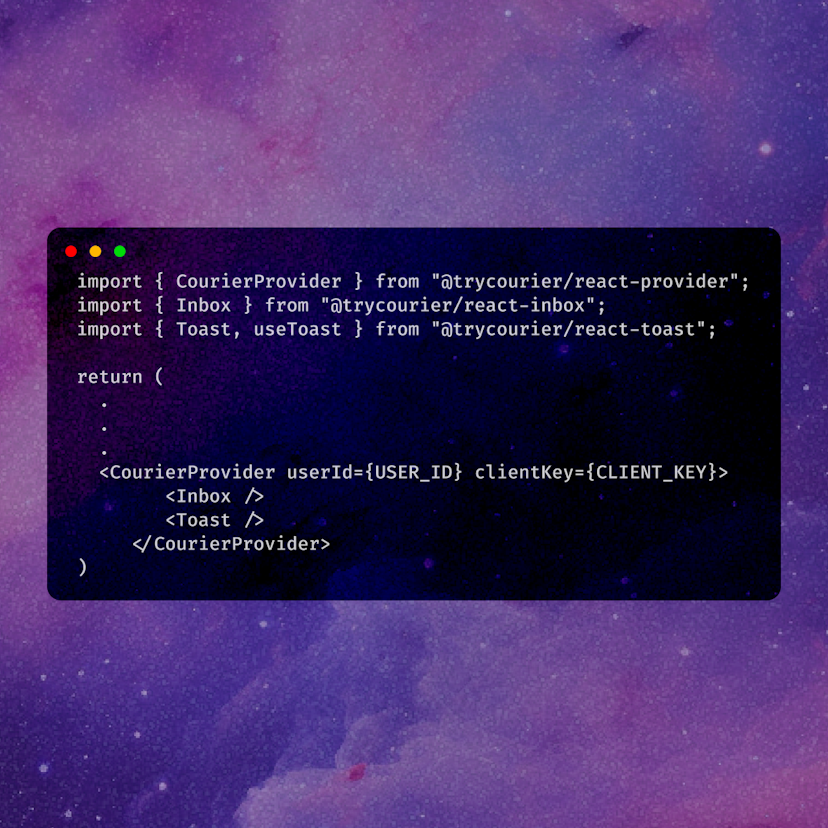Most Popular
Start Routing Notifications Today!
Courier is a notification service that centralizes all of your templates and messaging channels in one place which increases visibility and reduces engineering time.
Sign-up

Designing the Perfect Mobile Push Notification
Here at Courier, we recently announced a new focus on mobile notifications, which is the next big step to meeting our goals for our product. The biggest reason to focus on mobile is because it will drastically improve the user experience for anyone using mobile apps - which at this point, is everyone. This post explores the importance of building better quality mobile notifications and how to go about creating them.
The potential of mobile push
In a perfect world, a mobile push notification would be the perfect mode of communication between app and user. It’s the ping that your ride is here, the notice that your takeout has been delivered, and the heads up that the airline ticket you were considering is the cheapest you should expect it to get. Well-crafted push notifications are timely, immediately actionable messages that cement the bond between users and the product.
A 2017 study by Airship concluded there was a direct correlation between the frequency of your push notifications and your app’s retention rate. App users who received push notifications within their first 90 days had 190% higher retention rates than those who did not. Plus, frequent messaging could increase app retention rates by three to 10 times. It’s important to note that Airship is a push provider, so this isn’t exactly impartial research. But, it’s also worth noting that push notifications do consistently perform better than emails when it comes to click through rates and deliverability. Push notifications have open rates as low as 3.4% (average iOS performance via Swrve) and as high as 20% (BusinessofApps),depending on who you ask, as opposed to email’s 1-2% open rate.
So you have a notification channel (mobile push) that gets more interaction than other channels and could likely improve retention rates on your app - what’s stopping you from closing this article to send your users a push notification right now? Well, you’re amazing, and I’m sure your notifications are as well, but there are a lot of you’s out there, and it’s likely your user is already dealing with a plethora of notifications from them.
Learning from the history of push notifications
We’ve come a long way since the push notification was first invented in 2009. Today, these notifications are supported across Apple iOS, Google Android, Huawei Android, Amazon Echo, macOS, Windows, Chrome, Safari, Firefox, and Edge. Push notifications have evolved to include rich media, icons, customizable sounds, and up to four action buttons, among other developments. Today, the average US smartphone user receives 46 push notifications every day.
For every study that speaks to the value of push notifications, there’s another that speaks to their risks and pains. A 2021 HelpLama survey of over 500 US-based smartphone users perfectly illustrates the fine line notifications need to walk in order to be deemed valuable. While the aforementioned Airship survey recommended sending daily push notifications to improve user retention, 43% of the users in this HelpLama survey said they would disable the app’s push notifications if they received two to five a week. 13% of survey participants said they’d hit disable if they saw even ONE push notification. And 64% of participants indicated that receiving daily notifications would motivate them to stop using an app entirely.
At this point I’ll amend my topic sentence: a push notification is the perfect most polarizing mode of communication between app and customer. Assuming both push-positive and push-negative surveys are valid, how should you hold both in your mind as you plan your next push notification campaign?
How to send better mobile push notifications
Send as few notifications as possible
Notifications are only valuable if they’re relevant. Since push notifications don’t have the typically ignored spam or promotions folders email providers have, app deletion is often seen as the best solution to unwanted pings. To avoid letting users come to this conclusion, I’d recommend taking a step back and writing down a question before you send that first message:
Is this notification necessary for my user’s success?
If so, really try to press yourself and ask why. If it’s still an essential notification, decide which action users should take when they see it, write some copy that points users towards that action and send that sucker. Push campaigns will be more successful when rolled out cautiously and thoughtfully. As you build the essential messaging in your campaign, you’ll be able to step back and analyze how this notification adds value, how different segments of users are responding, and how messaging frequency and language might be better tailored to 60+ demographics vs. the 18-29 demographic. Well-crafted push notifications are thoughtful nodes in the product ecosystem. Poorly designed push campaigns are bacterial spores.
Context is everything
Within your user analysis, you should pick up details about when and where a user would like to be notified about your product. I know there’s a reason I receive more news articles in the morning and more pings from Netflix in the evening. These are the times of day I, and many users like me, are more likely to engage with those notifications. Netflix has a large team that has analyzed and optimized click-through rates across different time zones to create the strategy we see today. But this wouldn’t work for every engineer.
If you’re wondering when a user would like to hear from you, there’s a good rule of thumb: let them tell you. Duolingo sends nudges to study a language the user has already indicated they’d like to learn. An e-commerce site like Boxed might send you a reminder to complete your purchase if you abandoned your cart midway through an order. A content platform like Courses is designed to serve push notifications to users when there are pauses in streaks - consecutive days during which users have listened to podcast snippets and completed daily practice exercises. In all of these examples, the product didn’t send a push until it felt confident it understood its users’ interests and behavior.
If you want to read more about how to know what to say when, I wrote a journey mapping article earlier that’s about crafting empathetic interruptions in your user’s experience. Feel free to check it out for some more context.
Allow your users to set notification preferences
Allowing users to opt-in or opt-out, snooze, and schedule different categories of notifications can go a long way towards cultivating a user's trust in your product. This author has never been the biggest fan of the cortisol spikes he feels every time he receives a Slack notification, but the product does an incredibly good job offering granular preference control to their users all within the space of a modal. On top of the ability to join and leave channels (preference groupings in this context), users can schedule notifications, momentarily pause notifications, and even adjust their notifications sounds and appearance. This is of value to even the most skeptical push recipients. In the same HelpLama study referenced above, 61% of users will use the app more or at the same level if the notifications received are related to their preferences.
Aside from offering users a general sense of notification management, this level of granularity also offers important control to users with color and sound sensitivities. If the Slack “knock brush” default is grating to the ears, it can be changed to a ding, boing, drop, ta-da, or a female voice inexplicably saying “hummus”, among numerous other options. Slack also allows its users to decide whether or not they’d like to see a red unread badge when there are notifications waiting for them. In Twist, an app that positions itself as an alternative to those “burned out by real-time, all-the-time communication” they’ve done away with the red notification badge entirely because of the stress it induces. Whilehile Intercom offers moderated chat services that let users flag concerns about notifications they find obnoxious or distracting.
The future of mobile notifications is mindful, user-led communication. Check out how Courier is solving these problems by getting a demo here.
Start Routing Notifications Today!
Courier is a notification service that centralizes all of your templates and messaging channels in one place which increases visibility and reduces engineering time.
Sign-up
More from User Experience

Intro to your Courier Cheerleading Catalyst
Learn how Samar took her simple todo app to the next level by incorporating Courier to send cheerful and encouraging notifications.
Samar Barakat
July 07, 2023

Building a Great UX Outside of your App
This article argues that there’s a more important user experience than the one inside your app.
Nočnica Mellifera
September 06, 2022
Free Tools
Comparison Guides
Build your first notification in minutes
Send up to 10,000 notifications every month, for free.
Get started for free

Build your first notification in minutes
Send up to 10,000 notifications every month, for free.
Get started for free

© 2024 Courier. All rights reserved.